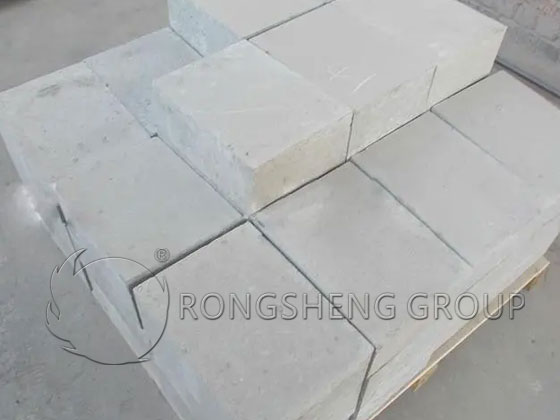Silicon carbide bricks use silicon carbide (sic) as the main raw material, and are equipped with various binders according to requirements. After high-pressure molding, silicon carbide brick products have good thermal stability, high thermal conductivity, and good corrosion resistance. They are commonly used energy-saving materials for industrial kilns. Silicon carbide bricks are mainly used for thermal treatment furnaces, laboratory muffle furnaces, glass annealing furnaces, enamel sintering furnaces, diffusion furnaces, and shed panels and flame insulation materials for various kilns.
ZhengZhou Rongsheng Refractories Co., Ltd. supplies silicon carbide bricks of standard and commonly used specifications all the year round. Our company can customize and produce various special-shaped silicon carbide materials according to the drawings of customers’ needs. Next, Rongsheng refractory manufacturers will show you about silicon carbide bricks. Welcome to consult and cooperate!

Rongsheng Silicon Carbide Brick
Refractory products made of silicon carbide as the main raw material. The silicon carbide content is 72%~99%. Generally, black silicon carbide (SiC content of more than 96%) is used as raw material, and a binder (or no binder) is added, and it is prepared through the processes of batching, mixing, molding and firing.
The main crystal phase is silicon carbide. The main varieties are oxide-bonded silicon carbide bricks, carbon-bonded silicon carbide bricks, nitride-bonded silicon carbide bricks, self-bonded silicon carbide bricks, recrystallized silicon carbide bricks and semi-silicon carbide bricks.
Rongsheng silicon carbide brick has the characteristics of good wear resistance, corrosion resistance, high temperature strength, good thermal shock stability, high thermal conductivity, and small thermal expansion coefficient. It is a high-performance refractory material.
Silicon carbide bricks have high thermal conductivity, good wear resistance, thermal shock resistance and corrosion resistance. It can be used for lining of aluminum electrolytic cell, molten aluminum conduit and kiln furniture for ceramic kiln, lower part of furnace body, waist and belly of large and medium-sized blast furnace, lining of aluminum refining furnace, lining of zinc distillation tank, etc.
How to Judge the Quality of Silicon Carbide Bricks
Silicon carbide brick is a refractory material made of SiC as the main raw material. Contains SiC 72%~99%. Divided into clay bonded, Si3N4 bonded, Sialon bonded, β-SiC bonded, Si2ON2 bonded and recrystallized silicon carbide bricks. Silicon carbide bricks have high thermal conductivity, good wear resistance, thermal shock resistance and corrosion resistance. It can be used for lining of aluminum electrolytic cell, molten aluminum conduit and kiln furniture for ceramic kiln, lower part of furnace body, waist and belly of large and medium-sized blast furnace, lining of aluminum refining furnace, lining of zinc distillation tank, etc.
When purchasing silicon carbide bricks, many users cannot distinguish the quality of silicon carbide products due to lack of experience when purchasing silicon carbide bricks and silicon carbide products. As a result, unqualified silicon carbide products are often bought, which greatly affects the service life of the kiln, increases the investment in refractory materials, and brings unnecessary losses to the enterprise. So how to distinguish the advantages and disadvantages of silicon carbide bricks?
First of all, the size specification of silicon carbide bricks should be accurate, and the specific gravity of silicon carbide bricks is generally between 2.45–2.6. If the specific gravity is too small or too large, it means that the material itself is impure, and other refractory materials must be added. Thereby greatly affecting the silicon carbide content and affecting the heat transfer performance of silicon carbide. When purchasing silicon carbide bricks, it is necessary to see whether there are missing corners and cracks on the surface of the bricks. Chipped corners and cracks should be acceptable within the range of the national standard, and if they seriously exceed the national standard, the quality of this batch of products is unqualified.